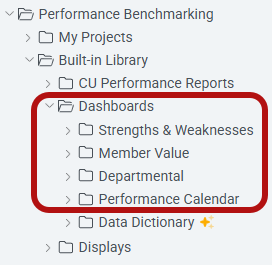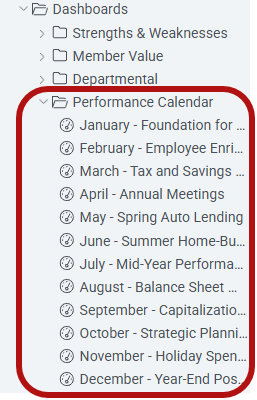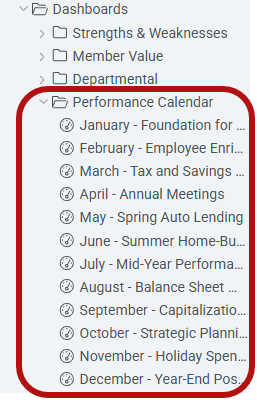Understanding Built-In Dashboards
Why Dashboards Matter
Dashboards in Peer Suite are designed to help credit union leaders connect performance metrics to strategy. Whether you’re preparing for an exam, a board meeting, or simply keeping tabs on operational trends, dashboards bring key insights together in one place, so you can focus on what matters most: serving your members.

Jump to a section to learn more:
Explore the Built-In Dashboard Library
The Built-In Dashboard Library includes four main dashboard groups designed for credit union use cases.

Strengths & Weaknesses
Explore performance across 10 key areas, from capital adequacy and liquidity to earnings and asset quality.
- Use it for: Annual strategic planning or exam preparation.
- Example: The 2025 NCUA Supervisory Priorities dashboard highlights key focus areas like liquidity and consumer financial protection to help you stay ahead of examiner expectations.

2024 NCUA Supervisory Priorities dashboard has been updated to align with NCUA priorities for 2025. Learn more here.
Member Value
Focus on Return of the Member (ROM), Callahan’s measure of how effectively your credit union delivers value to members.
- Use it for: Demonstrating member value in board or marketing reports.
Learn more about the Return of the Member Score in this guide.

Departmental
These dashboard address important metrics and areas of concern related to specific verticals within a credit union.

Performance Calendar
A set of 12 dashboards aligned with a credit union’s seasonal business cycle.
- Use it for: Monthly performance reviews or year-round planning.

Key Features of Built-In Dashboards
Callahan’s built-in dashboards come preloaded with analysis text and a star-based ranking system to help you quickly interpret performance and begin your analysis. Here’s a breakdown of what you’ll find:

Peer Pointer!
All Peer Suite displays include detailed formula f(x) breakdowns to help you understand how each metric is calculated. Learn more HERE.
Ratio Definitions:
This section provides foundational knowledge of key financial metrics, helping ensure consistency and alignment across your team and with industry standards.
Performance Analysis:
See the “why” behind the numbers. Each analysis includes insights into performance drivers and potential next steps.
Peer Pointer!
Keep in mind context is crucial for performance analysis. You will always understand the inner workings of your credit union better than we could.
- For example, you may notice that a credit union’s operating expense ratio is higher than its peers. While a lower ratio might seem better, there are a lot of other factors to consider like the number of branches, the complexity of their business operations, and their geography.
Star-Based Rating System:
A quick visual summary of how your credit union compares to peers.
Peer Suite assigns star ratings based on performance percentiles within your selected peer comparisons.
Star ratings are assigned based on a performance percentile, outlined below:
⭐ 1 star = <10%
⭐⭐ 2 stars = 11–39%
⭐⭐⭐ 3 stars = 40–60%
⭐⭐⭐⭐ 4 stars = 61–89%
⭐⭐⭐⭐⭐ 5 stars = 90%+
Peer Pointer!
A higher star rating means stronger relative performance, but interpretation depends on your goals and strategy.
- For Example: Looking at net worth, some might argue that having too high a net worth ratio could mean a credit union isn’t investing enough back in their membership or the future.
To access these features, open the Built-In Dashboard of your choice onto your canvas. Explore the textual analysis and star ranking by clicking on each features’ designated buttons, located at the bottom of each display.

Tips & Tools
Peer Pointer!
Want to export Analysis Texts, like performance analysis or ratio definitions? These are available only when using the PowerPoint export option.
You can choose to have the analysis text appear:
- On the slide itself
- In the PowerPoint notes section

If you’ve added Peer Notes to a display, these will automatically appear in the notes section of your PowerPoint export. Peer Notes are available at the Premium and Plus levels of Peer Suite.
The Data Dictionary folder is available at the Premium and Plus levels. It includes all displays with analysis text and is ideal for building custom dashboards and folders.

With this folder, you can quickly build custom folders and dashboards using display shortcuts, featuring analysis text.
- Want to see new metrics added to the Callahan Analysis Text Archive? Learn how you can vote to expand the archive.
- Ready to explore more? Check out this guide to learn all about using Analysis Text in Peer Suite!
Putting It into Practice
Use dashboards to support key activities throughout the year:
- Board Meetings: Highlight strengths and member value metrics.
- Strategic Planning: Identify trends using the Performance Calendar.
- Exam Preparation: Review NCUA Supervisory Priorities and core ratios.
- Department Reviews: Track functional goals and efficiency measures.
Looking for more information on the dashboards available in Peer Suite's Built-in Library? Check out the detailed breakdown below.
Built-In Dashboard Library Breakdown
Strengths & Weaknesses |
The first section within the dashboards folder focuses on exploring strengths and weaknesses across 10 topics. |
|---|---|
|
15 Key Ratios (Every Board Member Should Know): Dashboard tied to our series on creditunions.com. NCUA’s 2025 Supervisory Priorities: This dashboard has been updated for 2025 to reflect the latest focus areas outlined by the NCUA. It highlights key focus areas, including liquidity risk, credit risk, interest rate risk, and consumer financial protection, to help you stay prepared for upcoming examinations.
Growth: Various categories of growth are shown in CU Analyzer. These ratios are calculated using a 12 month growth cycle. Productivity measures how efficient employees are in serving the membership. For instance, how many accounts are there per member? Items to consider when looking at productivity include what is the rate of employee growth to member growth, what is the trend of the net income per employee, and what is the total member account growth? Earnings & Operating Efficiency measures the credit union's ability to successfully manage costs. Efficiency, compared to productivity, measures money in, whereas productivity measures money out. This is measured with the goal of controlling expenses and delivering a strong bottom line. Liquidity refers to the credit union’s ability to grow their deposit base so that funds are available to lend, as well as the amount of loans coming due in the near term that will be repriced at current loan and investment rates. Margin Management profiles a variety of measures to examine and analyze a credit union's profitability and interest rate offering relative to its peers. Asset Quality measures the soundness of the credit union’s loan portfolio by examining the current level of problem loans, the trend in loan quality, and the ability of the credit union to manage their problem loans. The key is to manage, not eliminate, risk in the portfolio Capital Adequacy is the cornerstone of a credit union’s ability to assure members that they are a safe and sound institution. The ability to meet members’ financial needs not only now, but in the future will create lasting relationships. |
Member Value |
These displays and dashboards relate to Callahan’s Return of the Member Score, used to measure the economic value that a credit union is providing to its members compared to the other credit unions in your comparison set. Learn more on this proprietary metric: HERE. |
|---|---|
|
Return of the Saver, the first component of ROM, is measuring how well a credit union is providing deposit services to its members. This part of the index measures more than just average dividend paid, though that is included. It also takes into account average share balance, the number of share accounts per member and the three-year growth. Return to the Borrowers, the lending component, recognizes that credit unions were created to provide credit to their members at a reasonable cost. The index rewards those credit unions that offer a lower rate on loans, but it also considers the historical growth in lending and the variety of products offered to its members. The final component is Member Service Usage. This component measures how efficiently a credit union provides and promotes services to its members. The leaders in this category are those credit unions that have a high number of core account relationships with their members. |
Departmental |
These dashboards address important metrics and areas of concern related to specific verticals within a credit union. |
|---|---|
|
Board Governance: Board members should focus on the key results of the credit union – growth rates, safety and soundness, earnings, and the value delivered to members. Strategy: CEOs stay on top of critical growth rates, the strength and focus of lending activity, sources of revenue, and the operating efficiency of the credit union. Finance: CFOs are managing the balance sheet by ensuring asset yields remain sufficient to provide members with solid returns and the credit union with strong earnings. Lending: CLOs are focused on growing a quality loan portfolio that optimizes loan yields based on current risk levels. Collections: Responsible for managing and recovering overdue loans and accounts to minimize financial losses. Mortgage Lending: Real estate is the largest component of the credit union loan portfolio today. Mortgage lending managers are looking to raise the visibility of the credit union’s mortgage lending program and become members’ first choice for home loans. Marketing: Marketing Managers are concerned with the credit union’s effectiveness at reaching members and maximizing their usage of product. Human Resources: HR Directors are charged with recruiting, developing and retaining a staff that is focused on serving members in an efficient manner while increasing their utilization of appropriate credit union products and services. |
Performance Calendar |
A curated set of 12 monthly dashboards designed around a credit union’s seasonal business cycle, helping leaders analyze performance metrics aligned with member trends like tax season, annual meetings, and holiday spending |
|---|---|
|
January- Foundation for the Year: February - Employee Enrichment: March - Tax and Savings Season: April - Annual Meetings: May - Spring Auto Lending: June - Summer Home-Buying: July - Mid-Year Performance Review: August - Balance Sheet Management: September - Capitalization Review: October - Strategic Planning: November - Holiday Spending: December- Year-End Positioning: |




